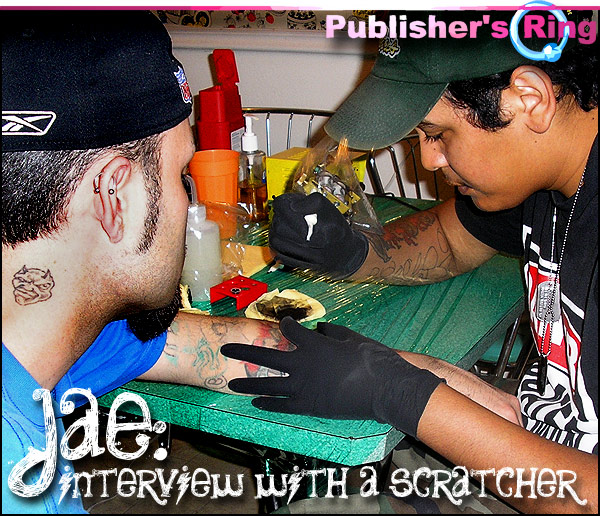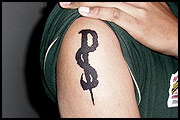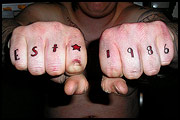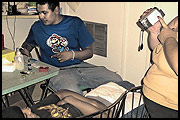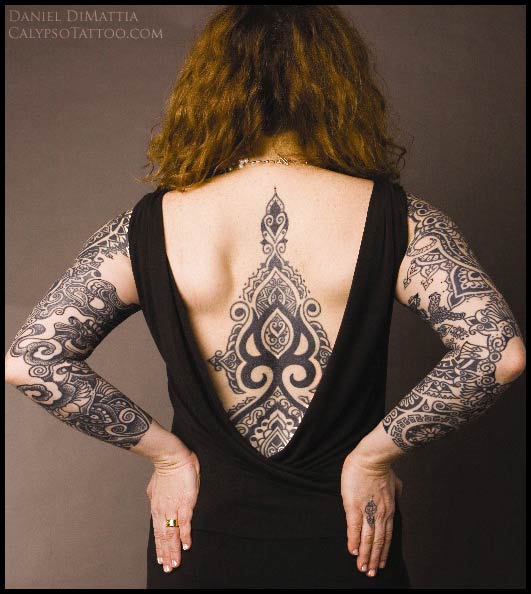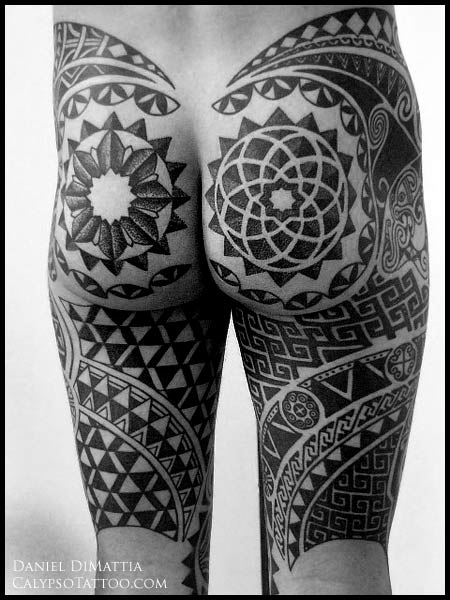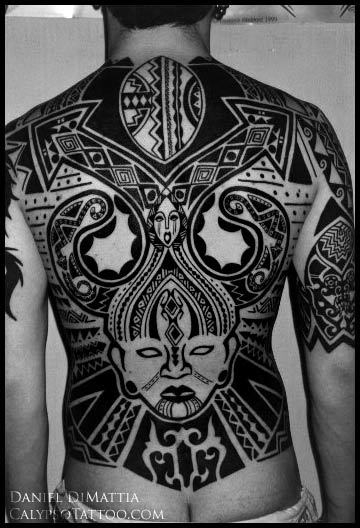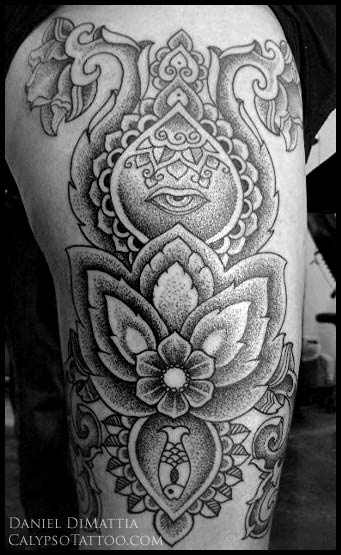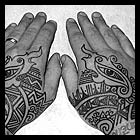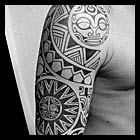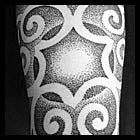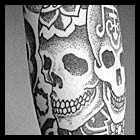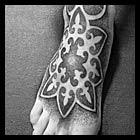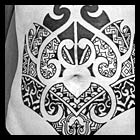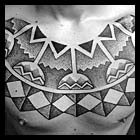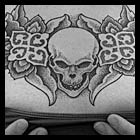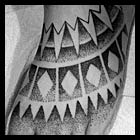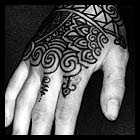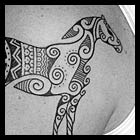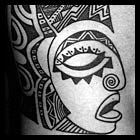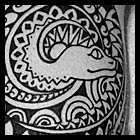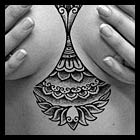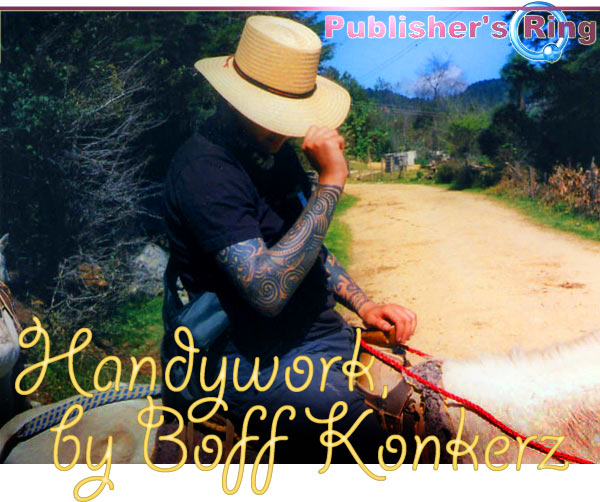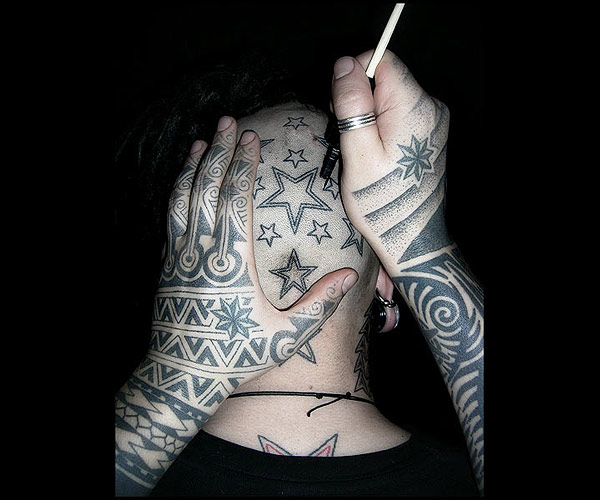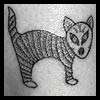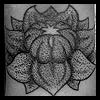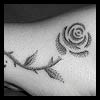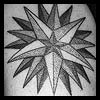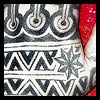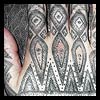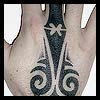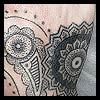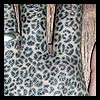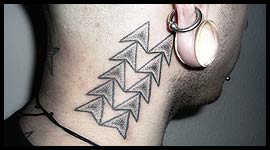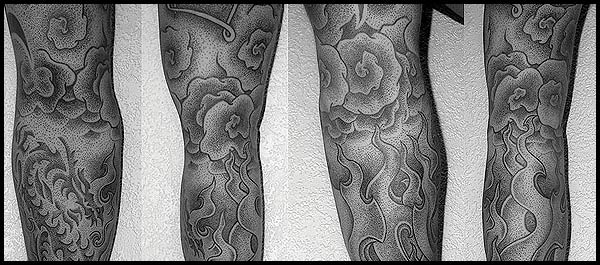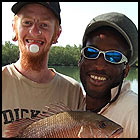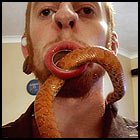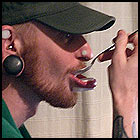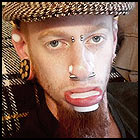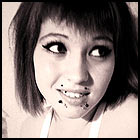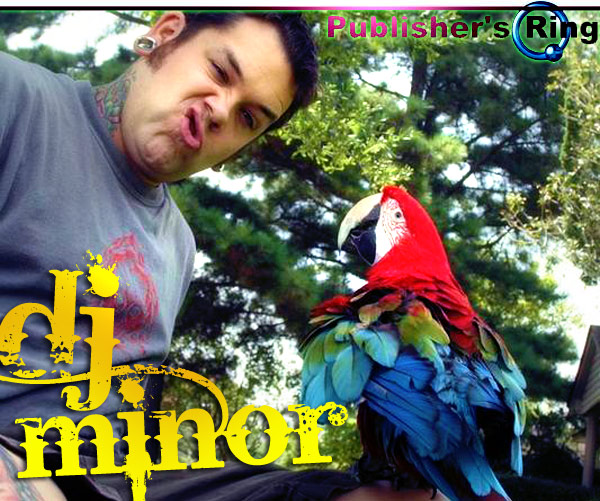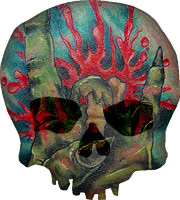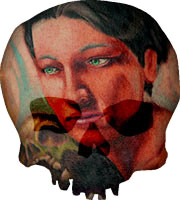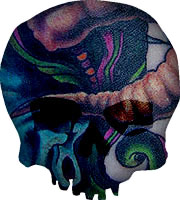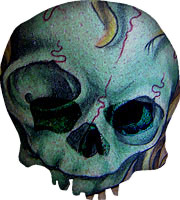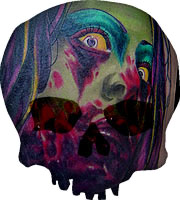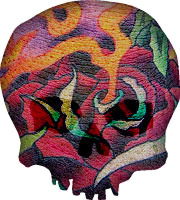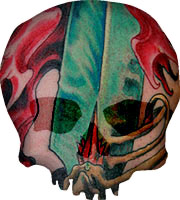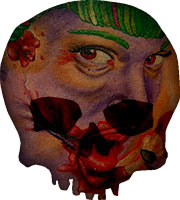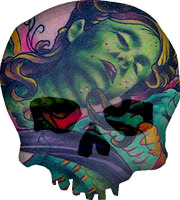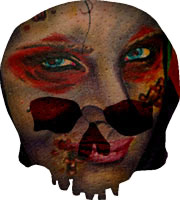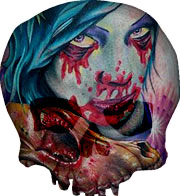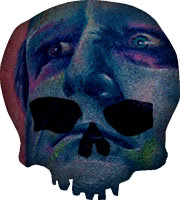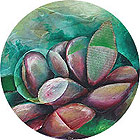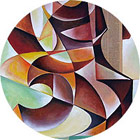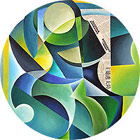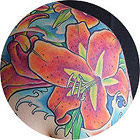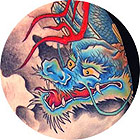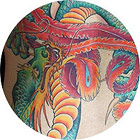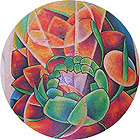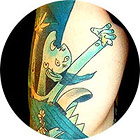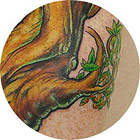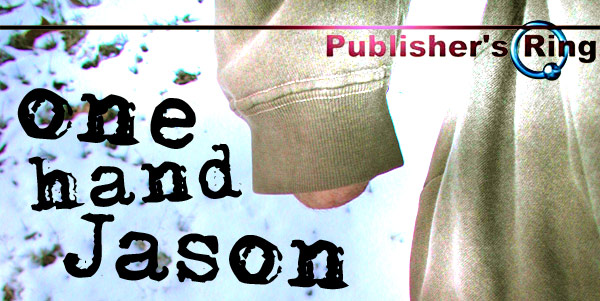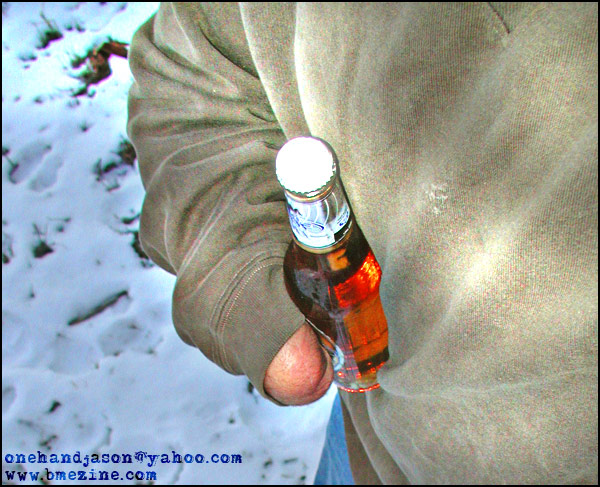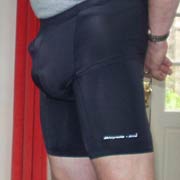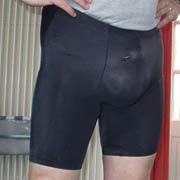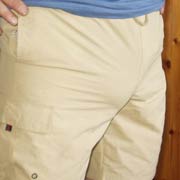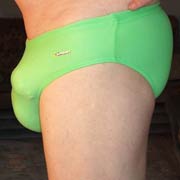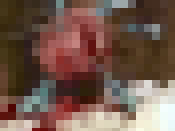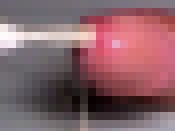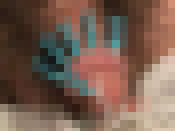|
“Scratchers,” both the outcasts and the heart of the tattoo subculture are our very own untouchables. They make up a large percentage of the tattoo world and all together do millions of tattoos, but they’re widely maligned and rarely spoken of by the so called “elite” — BME included — that publish magazines and websites. Of course this is the perfect formula for misunderstanding, and I thought maybe we were missing out on some interesting stories. My friend Jae, a home tattoo artist putting out work currently of dubious quality (sorry Jae!), was willing to put himself up on the block and candidly talk to us about his little piece of the tattoo world, and I thank him for that. Please note: In no way am I trying to encourage home tattooing or tattooing before you’re ready to do good work. I’m presenting Jae here not for his tattooing per se, because I like him, enjoyed hearing his story, and think many will relate to him as a person. * * * BME: Were you are artist as a kid? Well, I wouldn’t exactly say I was an artist, but as a kid I always loved to draw. I used to watch my “father” draw and wished that I was able to draw as well as him. He was always in and out of prison so I got to sit there and mess with his art. Sometimes I would trace it and hang it on my wall, and after a couple of years I was able to look at something and draw it free hand, but when I tried to create my own art it looked as though I had no kind of talent at all. I guess it did come a little later because now I can create my own art and it actually looks alright… BME: That’s actually a really nice story — so you learned to draw and became inspired about tattoos because they symbolized your father? Yeah, my father has inspired me in a lot of ways, mostly by his art. He tattooed in prison but that’s all he ever told me. He didn’t like talking about prison too much, except for the fights he’d get into and the dirty work he put in. BME: I guess you grew up around tattoos? I’ve been around body art since I was a kid. I used to watch my father tattoo and pierce all of his friends and their girlfriends. I was always so captivated by tattooing and wanted to try it so bad that one day I tried to make a tattoo quill. I got some India ink and tried to tattoo Batman on my hand but that didn’t work out so well. The first time I poked my skin the ink was so thick it wouldn’t go in… It kinda just sat on my skin, and then my mom walked in my room and beat the hell out of me, hahaha… So about a year and a half ago I finally decided to buy a tattoo kit and I’ve been tattooing since. BME: Haha, yeah, my mom wasn’t too happy either when she discovered that I was poking tattoos into myself in my bedroom as a kid. My father didn’t mind though — how did yours react? Well, my father was in prison when he found out about the whole tattoo thing, so he didn’t really care too much about what I was doing — I think mainly because he couldn’t do anything from behind bars so he didn’t really say anything about it. That was pretty much the last time I saw him because when he got out of prison he disappeared.
BME: What was the first tattoo you ever put on someone else? My first tattoo was a heart that I put on my wife’s wrist. Right now it’s just a really thick outline — it’s about the size of a dime. It took me like half an hour to lay the ink in because I didn’t know what the hell I was doing! She whined the whole time, hahaha, and then she decided that I needed one too, so she tattooed me as well. It really isn’t so much ffun when the shoe is on the other foot! She likes to watch me squirm, but she’s really good at what she does as long as she’s not mad at me! BME: Yeah, I remember filling in my first tattoos and how long it took, not knowing how to do it. How many tattoos have you done in all now? I’m not to sure how many tattoos I’ve done so far but I’m gonna guess anyway… probably about twenty-five. BME: What kind of tattoo equipment do you use and why? Where did you get it? I use a Gold-Slinger for my line-work and a Wasp tattoo machine for shading, and the metered power supply that came in my kit, and a Tread-Lite foot switch and clip cord. I also have a machine that a friend traded me for ink work. I’m not to sure what kind of machine it is but it’s pretty smooth running. I got most of my equipment from Superior Tattoo Equipment. It’s a little tattoo supply shop down the street from my house. BME: How do you control sterility and cross contamination? I usually cover my machines with baggies and wrap my surface with industrial saran wrap. I use disposable needle tubes and dispose of my needles in a sharps container, and I use medical wipes that kill everything from HIV to the common cold, and I use gloves. In some of the pictures I’m not doing all of these things because they were taken before I learned how to prevent bloodborne pathogens and cross contamination. BME: So in short, solving the problem by using disposable gear rather than an autoclave? Yes, I figured it would be the easiest way to do it. I don’t have to worry about not properly sterilizing something and making an enemy out of one of my friends! BME: What are your favorite sorts of tattoos to do? Pretty much anything that’s big — a tattoo that I can really get down with and throw my own little things into, to kinda make it my own… but little tattoos are fun too. I would really like to find someone that would let me go hog wild on their skin because I feel like I really learn more about myself when I’m tattooing a piece of art that I created myself… I pour a little piece of myself into it. BME: Do you like shows like “Miami Ink”? Honestly, I’ve never seen “Miami Ink” — I’m not much of a TV person, but I hear good things about it. I think that the popularity of tattoos is a good thing because people are opening up and accepting different ways of being. We live on a planet that is so diverse and beautiful — to shun someone else’s beliefs and way of life or personal expressions is so sad and closed-minded. I feel that everyone should embrace life and not just live it. BME: Would you actually like to tattoo for a living? Sometimes I think about it, and I’d love to find more clients, but then I remember that the clients that I do have have been with me since the beginning — mess-ups and all, and I can give them my all and not just another tattoo. I love to tattoo and I don’t want it to turn into just another job — I want to do it because I love it, not because I have to pay bills. I’ve got a day job for that! BME: I definitely appreciate doing it just for the love of tattooing, and I like how it’s a part of your friendships as well. Yeah, in a big way it helps us bond and all of that good stuff, and it also makes us trust one another more — it brings us closer to each other. I guess it also gives us something productive to do with our time instead of running around all wild and getting into trouble. I’ve managed to stay out of “the county lock-up” since I’ve started tattooing! I am trying to push myself to my limits by creating my own art and discovering exactly what I’m capable of doing with my creativity. I’ve been looking at a lot of other peoples styles and trying to use their art for inspiration. BME: Do you draw or paint as well, or do you prefer to work on skin? I draw a lot, but I love to work on skin — it’s so much more challenging when you can’t mess up. You don’t want someone walking around with a snake on their arm that looks like a penis or something! BME: Assuming you keep tattooing, how do you think you’ll feel about these early tattoos you’re doing now? Well, I’m not too sure — that’s a hard one! I think that they’re okay for a beginner, and I know I need some improvement, but I also know that when I’m in my prime I’m gonna look at them and ask myself, “did I really do that?” Hahaha… BME: Haha, no doubt. Free cover-ups in the future for all your current “victims”? Would you describe yourself as a “scratcher” right now? A “scratcher”? Well, I’m not to sure what that is but I know I’m a “digger”. BME: Sorry, “scratcher” is a negative term for someone who’s doing tattoos that aren’t the greatest… I think that’s probably how most people who are used to high-end work will respond. Oh. Well, in that case, I think I’m somewhat of a scratcher, but then again I’m still a beginner! I feel that no matter how good your work is there’s always room for improvement, and that’s something I strive for. I want to be the best that I can be — improvement is always a good thing, whether you were taught by the best of the best or if you’re self-taught like me. BME: I tattooed for a while and some of my pieces were pretty lacking technically, so I definitely don’t mean this in an insulting way — how do you feel you work compares to other work out there? Oh, no, I understand… I feel that my work is okay, and I know that if I got a chance to pull out all of the stops — and cigarette breaks — I could really create a piece of art that would leave people in awe. For now though, I’m probably gonna have to beg a few people to let me fix up some of my previous artwork, or lack thereof… If I had my wish, I would like to go to art school and learn as much as I can, and apply all that I’ve learned to tattooing, and maybe open up my own studio. I’d love to teach people who want to learn the art of tattooing to tattoo, because it kinda sucks to learn the hard way… but at the same time it’s an experience that I wouldn’t trade for anything in the world. BME: What do the people who’ve gotten work by you so far think of it? Okay — I’m not gonna lie. I’ve done some really bad work… Some work that those poor unlucky bastards are gonna regret! I didn’t take their money because I figured they had already paid enough, hahaha… Okay, that’s not funny… But seriously, most of my clients love my work. BME: If you could ask a high-end artist for advice, what would you ask about? Honestly, I’d love to know anything I need to do to improve my work — what should I do differently? What haven’t I been doing that I should? How do I shade from one color to another? How do I get more detail? What’s the best way to do a cover-up? How do I do realism and do portraits? BME: Sounds like there’s a long way to go — good luck, have fun, and thanks for agreeing to talk about this publicly!
|
Tag Archives: the-publishers-ring
Post navigation
Daniel DiMattia (Calypso Tattoo) Interview in BME/News [Publisher’s Ring]
|
-Ken Cohen, The Way of Quigong
It’s been my observation that not only do great tattoo artists exude raw artistic talent, but that they are also people of great humor, kindness, and wisdom. I believe that Daniel DiMattia, a master of neo-tribal tattoo art and a decade-and-a-half veteran in the field has all of these traits in abundance. His beautiful blackwork has long been some of my favorite ink posted to BME, and it was a pleasure to finally be able to interview him. You can find Dan at Calypso Tattoo in Belgium. He travels regularly, so visit his website for more photos, contact details, and information on upcoming conventions he’ll be at.
* * * BME: What got you drawing? I’ve been drawing since I can remember — that doesn’t mean I was good — but I was always drawing, like a compulsion. I attended art academy, but only lasted a year and half because I felt I didn’t fit in. I came from the street, I was rough. I wasn’t sensitive and feeling creative vibrations from everything around me like the others. It made me uncomfortable so I left. But I always kept drawing and tried to teach myself. Then I found tattoos and it felt more real, closer to people, still creative but grounded in reality. BME: What kind of exposure did you have to tattoos as you were growing up? When I was young in Belgium, tattoos seemed limited to hand-done scratcher tattoos, usually on those who spent time in jail. So I was attracted to it because I wanted to be cool. At age 14, I took a metal compass and some ink and tattooed a cross on my arm — it was awful and my parents went insane. Fourteen years later while traveling around Europe, I met people with real beautiful tattoos, real works of art, and it inspired me. From then on, I decided I wanted to learn to create art on skin. I was living in Sweden in the eighties and boxing in a club where there were a lot of skinheads. Many of them had fine line, black and grey tattoos. Doc Forest, the Swedish godfather of fine art tattooing in Europe, was creating these illustrative, painterly tattoos. Amazing work. So naturally, I first went to him when I decided I wanted to learn to tattoo. He was nice but didn’t need any help at the time, so I was out of luck. Then I returned to Belgium and couldn’t find any tattooists here to teach me either. But I did find books like Ed Hardy’s Tattoo Time series and the first biker/tattoo magazines and this helped because they also advertised tattoo equipment. One advertisement offered machines, autoclaves, tubes, needles — the whole kit for beginner tattooists. The address was in New York and for me at the time, New York meant NYC, so I went to the States for the first time in my life. I ended up renting a room in Staten Island from another ad in the magazine. It was in a pretty dangerous place. A real experience for this guy from a small city in Belgium. I took the ferry to Manhattan and went around asking people — showing them the ad — where could I find the address? Turns out, it was in upstate NY. Three hours away! I called the place and they said I could have ordered the kit in Belgium with just a credit card. So, I went back, got a credit card and ordered. But before I did that, I tried to find tattooists in NYC. Tattooing was still illegal at the time and everything was underground, so again, no luck! It was an adventure though. As you can see from my story, it was really tough trying to be a tattooist at that time. No eBay for tattoo kits. No Internet for techniques and tips. You had to go out and search for everything yourself. BME: You’re self-taught? I started learning on myself. This is why my legs look so bad! I also started going to conventions like Amsterdam and Dunstable at the time and just watched the artists work. This helped a lot and also increased my desire to do the type of work that I was seeing there. Refining the craft is about practice, pushing yourself to do better but also experimenting — finding better equipment, and trying out new tools and techniques to see what works best. BME: Besides going crazy about the first tattoo you did on yourself, what do your parents think about your career choice now? My parents are Italian immigrants in Belgium. My father worked the mines and my mother worked in a factory, so their lives weren’t easy. Like many immigrants, they wanted security and tattoos didn’t represent that. But once I showed them that tattooing is not only an art but a business they came around — but it took a while. * * *
* * * BME: Tell me about how you actually started tattooing professionally. I started tattooing professionally in 1992. The first one was a snake coming out of an apple — not a very exciting start for the design but for me, everything was exciting just to practice how to do a good line and get that color in. For four years I did all types of tattoos, but I began to specialize in blackwork after more and more people were coming to the shop asking for tribal tattoos. I realized that there was more to blackwork than just traditional tribal patterns. There is more you can do with black ink. Because I am using only one color, I have unlimited uses of forms and design. To experiment with backwork on a large scale, in around 1996, I started tattooing local punks for free but they had to give me their backs and arms to do whatever I wanted. This is really how I started developing my own style. A lot of them came with me to conventions and showed the work I did on them, entered contests, and that’s how my work began appearing in magazines. Conventions helped promote my style of work. Again, at the time, Internet access wasn’t in every home here and there was no vast tattoo media as there is today, so people couldn’t see your work unless you went out there and showed them. BME: What influences you as an artist? I am influenced by any art that is well balanced, has an interesting shape and gives off a strong attitude, which includes many feminine shapes. I am influenced by gothic motifs, African patterns and masks, Asian art — all ornamental designs give me inspiration to create something different every time. I’m also influenced by my clients — some of my favorite works are inspired from the wild imaginations of my clients. BME: How do you usually work with a client to come up with a piece in your style? In general, I ask people who come to me what they are most attracted to out of my portfolio, whether it’s abstract dotwork or more traditional Polynesian or a fusion of ethnic styles. I then create a work that is special to the client. Sometimes I ask questions about the person’s life because I can incorporate design elements and symbols that tell the person’s story. BME: Do you ever turn clients away? I turn people away who are not certain of what they want. A person must be certain that they want to get tattooed. I never want anyone to walk out of my studio with regret. I love my job because it is the opposite — people walk away happy and that positive energy drives me. BME: Does working in black only limit you as an artist? Working in black pushes me as an artist because I don’t have a large pallette of colors to work from so I have to keep researching and finding ways to stay fresh and create different works for different people. While I love old school and Japanese work — and have some on my own body — it would take a lifetime to learn how to do it really well, so I’ll leave that to the others who specialize in it and admire their work. BME: I saw you’re doing more and more dotwork tattoos. There’s been some debate on how well these will age — do you feel they will do better or worse in the long run than “normal” tattoos? Dotwork ages very well. It’s less damaging to the skin, softer, and tends to heal better — all factors affecting longevity. But with any tattoo, it’s about how well you take care of it and your lifestyle. If you’re constantly in the sun, if you gain or lose weight in extremes, do drugs or any other activity that’s bad for the skin and your health in general, it will probably show in the tattoos. So if you lead a healthy lifestyle, you’ll protect your artwork investment. * * *
* * * BME: As a “famous” tattoo artist, have you had any “famous” clients? I had a famous footballer (soccer player) come into the studio once with his entourage thinking that I was going to stop everything to do a little tattoo for him — he didn’t even know what he wanted. These guys are treated like gods here but I could care less. I told him I was busy and to make an appointment — and leave a deposit so I know he’d come back. He couldn’t believe I would even ask such a thing and his crew was saying, “Do you know who this man is?” Kicking a ball around a field for a lot of money will not earn my resepct. Leaving a deposit will. I never saw him again. I’ve actually had a couple of ‘celebrities’ from the U.S. contact me, but I never worked on them because I could [would] not accommodate them the way they wanted. My favorite clients are the ‘average Joe’ as you say in English. Students, soccer moms, engineers, electricians, and a redheaded lawyer on occasion. People who come because they love tattoos. BME: Redheaded lawyers, eh? Ahaha! I found my wife through tattooing! We met at the NYC tattoo convention in 2001 and a couple of months later she was living with me in Belgium. (We married in 2005). We share the same passions and philosophy, which is a foundation for any couple. BME: If you could choose any three tattoo artist to tattoo you, who would they be? Wow. There are so many and so little space on my body! Xed from Into You in London — his compositions and dotwork are inspiring. I like the traditional Polynesian work of Manu and the hand Samoan work by Pili Mo’o, and I love the new color work from people like Nikko, Mike DeVries, and Tim Kern. BME: Quite a few of the tattoo artists I’ve talked to lately have mixed feelings about the massive mainstream popularity of tattoo reality shows like “Miami Ink” — how do you feel about them? I think it’s good and bad. These shows inspire people to get custom work and not just flash off the walls. It shows the process of tattooing and educates the public, which helps remove the negative stereotype about tattoos. But it also creates new stereotypes like a person has to have some great story behind every tattoo, which I don’t believe. BME: Any interest in being on one of those shows? I was offered an opportunity to appear as a guest artist but I never did because I didn’t want to play a part. I’m not an actor. I don’t think a TV appearance would make me a better tattooist. I don’t see how it would enrich my life. * * *
Dotwork Thigh
* * * BME: What do you think the future of tattooing holds? It’s always the same, under the skin! Whether it stays fashionable as it is now or loses its popularity, it will always attract those who feel the compulsion to mark their bodies. I believe it is a genetic drive in some people to mark their skin. This does not follow fashion. BME: I agree completely. How do you feel about tattooing faces and other public skin? I’ve done hands, faces, heads, necks — all public places. I take it very seriously. Decorating the face, to me, relates to the divine, the spirit of the person. It’s more than just decoration, like the hands, which are related to creativity. So in doing the face, the person must have a certain ideology, a philosophy behind the desire. BME: What would you do if you weren’t a tattoo artist? A massage therapist. A QiGong teacher. Something that will make people feel good about their bodies and their spirit. BME: Speaking of massage, have you experienced any physical problems from a decade and a half of tattooing? I did experience a great deal of back pain; that is, until I found T’ai Chi and QiGong. This unblocked my energy in my body and loosened me up so that I’m better able to absorb the tension from tattooing in difficult positions. I recommend it to everyone. It made such a difference in my life and I feel I can go on tattooing for many years to come because of it. BME: I saw a piece in your portfolio where you’d tattooed next to a large scarification piece — how do you feel about the rising popularity of other forms of body modification like this? If a certain body modification speaks to someone like tattooing does for me, then who am I to judge? BME: What are some tips that you would offer to young tattoo artists seeking to better themselves? Don’t be afraid to freehand your drawing on the body. It’s a great exercise in creating a flow and harmony with the body. Also, go to conventions and watch how your favorite artists work. These days, people are more open, so you shouldn’t feel shy to ask questions — but politely of course and at the right moment. I’m pretty free about giving advice to young artists at conventions, except those that scream in my client’s ear about what kind of needles I’m using, or spilling beer on my booth. BME: Have you ever apprenticed anyone? I did apprentice someone once, someone I treated like a son, and in return he showed me disrespect. It was a hurtful experience and I don’t have the desire to apprentice anyone again. Well, maybe for a lot of money when I’m old and have arthritis! * * * A Gallery of Tattoos by Daniel DiMattia * * * BME: Finally, how do people get in touch with you to book an appointment, what’s your typical touring schedule? The best way to get in touch with me is via email — although I always appreciate people’s patience because it can take me a while to answer. Also, English is not my first language so for very detailed emails, my wife helps out and I’m at the mercy of her very busy schedule. My touring schedule varies and this year we’re starting to slow down on the number of conventions we’re doing but there are always staples that I work like the NYC Tattoo Convention May 16-18 and the London Tattoo Convention September 26-28. I’m also excited to be a part of a new convention by Skin Deep Magazine in North Wales coast called the Tattoo Jam, August 1-3.. Especially for conventions, I usually take appointment months in advance, but people can always contact me to see if there are any cancellations. Beyond the NYC Convention, I also come to NY a number of times during the year to work on clients at Tattoo Culture in Williamsburg, Brooklyn. Of course, a lot of people travel to Belgium and we’re happy to help them make arrangements for their “tattoo vacation”.
|
Boff Konkerz Hand Tattoo Interview in BME/News [Publisher’s Ring]
|
– Thomas Carlyle
For at least ten thousand years tattoos have been installed by hand, poked dot by dot using a variety of manual tools. While most modern artists now use high-speed powered devices, artists like 36-year old Boff Konkerz are keeping the traditional spirit alive as he visits clients’ homes in England’s East-Midlands region and abroad in his travels doing handwork tattoos. Boff has been tattooing for four years now, and recently talked to us about his art and experiences. You can get in touch with Boff via myspace.com/tattoosbyhand.
BME: How did you get into this career? I don’t really think of this as a “career”, but I got into it by accident, or it was fate depending on your view. I enjoyed art as a child, but didn’t take it seriously until I started designing tattoos. I designed my first tattoo myself and later started drawing for friends. As a teenager I was into punk rock and tattoos kinda just went along with that. When I first started I honestly had no intention of doing it for a living, it was a skill I just wanted to acquire due to a genuine interest in the art form. I did it in exchange for pizza and beer back then… I actually can’t remember when I moved into tattooing for cash. Even now I’ll tattoo friends for food and drink. BME: Besides pizza of course, what is the normal pricing for hand tattoos? It really varies from job to job, but my basic quote is £30 ($60) per hour, if it’s big work I ask for a commitment of three hours a week until the piece is done, because of the slow nature of handwork I want to be sure they are committed to getting the piece finished. I am able to keep my prices low as I’m not paying rent on a studio. I also add any travel expenses onto the price per session. BME: How did you actually learn? I acquired my first piece of handwork from my good friend Xed Le Head and was interested in learning how to do it. I was already quite heavily tattooed by machine at this point, but had never had the desire to learn to tattoo by machine. When Xed did those first pieces of handwork the penny kind of dropped and I knew it was something I wanted to do. I was gonna ask Xed to give me some advice, but the night I was gonna ask him he wasn’t around, so Lucky Diamond Rich showed me how to make a needle and I did my first tattoo on him and tattooed myself that same night. Shortly afterwards Xed shared some of his handworking techniques with me and after that it was a process of practice, trial and error, and perseverance. BME: What would you say to someone who sees hand poked tattoos and says “I can do that”? How should someone learn? Find a hand tattooist and get some handwork — just watch at first, and then try asking some questions. And yes, try tattooing yourself. I’d like to say something in defense of “bedroom tattooists”. I read recently in a national newspaper here a criticism of bedroom tattooists by Louis Malloy [editor’s note: you may know him from TV’s “London Ink” or as “Beckham’s tattoo artist”]. The truth is half of my work is fixing terrible tattoos executed by “artists” working from tattoo studios. Anyone with the money can open a tattoo studio, and getting tattooed in a studio is no more a guarantee of getting a good tattoo than getting tattooed in someone’s home is a guarantee of getting bad work. Life ain’t that simple. Although I’m proud to be part of a DIY tattoo tradition, I’m not opposed to working in a studio. Job offers can be sent to me via email! BME: Speaking of Louis, what do you think of shows like “London Ink”? I think those shows are the fucking pits. I hate them, they are an abomination, and the worst thing to happen to tattooing in 10,000 years. Would I appear on one of these shows if asked? Of course! BME: It would definitely be an improvement if they added you to the cast! BME: You said you do a lot of repair work — how do you feel about scratchers and lower-end tattoo shops? Tattoos teach us a lot of things, you often learn more from mistakes than from the things you get right. A shitty tattoo can be the right tattoo for someone at that stage in their development, if it teaches them to think things through. You either walk into a tattoo studio with your eyes open or your eyes closed — your choice. Responsibility for your tattoo ultimately lies with the customer. I really like the idea of “healing” a machine inflicted tattoo using hand tools. BME: What’s the actual tool you use for tattooing? I use conventional tattoo needles lashed to half a chopstick. BME: How long do hand tattoos take to do in comparison to machine work? It depends on the design, but I’d say three times longer. BME: What influences you as an artist? I like to look at textile designs, porcelain, wallpaper… anything but tattoo flash. I love Picasso, Miro, Goya and Frida Kahlo, but I don’t think their influence can be seen in my tattoo work. BME: What are your favorite sorts of tattoos to do? I love to tattoo hands, regardless of the design. BME: Why hands? Because of how they move or how they’re always exposed to the public? Yes, the way they move, and the way they are exposed to the public, but also something on a more subconscious level… I don’t know what, but I’m happy to be involved with it. The leopard spotted hand for example, which took about twelve hours, is my personal favorite of all the tattoos I’ve done. Also, I think handwork is better suited for tattooing the hands than a machine is. You often get blow-out on the fingers with a machine, but I never get blow-out. BME: I know you’ve done necks, but do you tattoo faces? I won’t tattoo faces until I have my own face tattooed. Left is Boff’s neck by Xed Le Head, and right is a Neck tattoo by Boff. BME: Do people usually come to you with a design in mind? Usually they say something like, “I want a rose on my hand,” and I go home and draw something up, and nine times out of ten they like it and away we go. Even better is when they just say, “I want a sleeve.” Then I can really go to town. A lot of my work is cover-up and repair work, so obviously then I have to work around what’s already there, but I like the challenge of that too. BME: On a design level, and what works, what sort of tattoos work best for hand-poked tattoos? I generally only use black ink and a lot of dot shading. I can do solid black but it takes a very long time — shading with dots I believe I can do as fast as a machine though. Other than that, anything goes. On a personal level I dislike portrait tattoos and won’t do them — I think it’s just weird having someone else’s face on your body! BME: What does the future of tattooing look like to you? It’s only gonna get bigger, which will be both a blessing and a curse. As any industry grows it also diversifies. This will mean that the industry will be taken out of the hands of enthusiasts and uploaded into the mainstream dominant culture. Most tattooing will become formulaic and be tailored to the mass market. The plus side to all this is that the art will be big enough to support an underground scene. Think major record labels and indies in the music industry — this is already well on the way. BME: Have you experienced physical problems from tattooing? Yes, I have problems with my right wrist, but this could be from masturbating. BME: Have you done any touring? I took my tools with me when I went to India recently, and I thought I’d tattoo a few backpackers out there, but I only tattooed Indians, which was great. It’s better to tattoo in my own area as I have a reputation there and so people trust me. People who’ve never encountered handwork are often wary of it, and they often think it’ll hurt more — most of my clients say it hurts less — or that the work won’t be to a high standard, which it is!
BME: Is this your full time job, or do you do other work as well? It’s my only job. I earn a living, but it’s not reliable. I try to limit myself to five jobs a week — Monday to Friday, with weekends off. Having said that I did seven tattoos last week, and one this week. I like to do one tattoo per day because of the traveling involved, but if two of my customers know each other, I’ll do both of them in the same day at the same house. This happens a lot, as all my advertising is by word of mouth, so many of my customers know each other. I tattoo a lot of people who are related to each other. I don’t put out posters or fliers or promote myself in any way. BME: Finally, if you weren’t a tattoo artist, what do you think you’d be? A rentboy, which I was before tattooing. BME: On that note, thanks for talking to us!
|
Evolution is Beautiful — BME/News [Publisher’s Ring]
|
– George Sheehan
Like Toph who I also recently interviewed, G.C. (iam:G.C.) is one of a growing handful of people choosing to stretch their lip piercings out to dramatic sizes, defining an entirely new aesthetic code, unique in Western history. As well as other stretched piercings, he currently wears a 41.5mm plate in his lip, and took some time out to talk to us about his successul life — which you may be surprised to hear is full of fishing trips and a cadre of unpierced friends.
|
DJ Minor Tattoo Interview in BME/News [Publisher’s Ring]
|
– Dr. Foster, Dawn of the Dead
After rejecting art school for a stint in the Navy, DJ Minor commiserated a few bad jobs at a tattoo shop near the base, and not long afterwards found himself tattooing tribal armbands on GIs… He just “kept waking up as a tattoo artist”, and the rest is history. You can find him at TastySquirrels.com and KantReed.com, and on Myspace as djminor.
* * * BME: How did you get into art and tattoos? I wasn’t drawing portraits of my friends at age three or anything, but I was steadily drawing from the third grade on. I got into photography and technical illustrations in high school due to a very persistent High School Art Teacher. She got me all revved up about a serious art career — as long as it wasn’t photographing kids at SEARS she would be excited. Time goes on and I got a full scholarship for an art School in Savannah, GA, which I turned down for a trip to boot camp. This threw me into a different art reality of the tattoo parlors beside the base. I would have been awesome at SEARS though. BME: Were you also exposed to tattoos as a kid, or were the base parlors the first time? My uncle was in the Navy and was covered with little demons, and flowers from all over the world. It was really interesting since South Carolina, where I am from, didn’t have legal tattooing, or many heavily tattooed people. When I got out of the Navy myself I was covered in the kind of tattoos that make laser treatment techs rich — but visibly covered none the less. Living in the southern heartland didn’t really take well to a twenty-something all sleeved out with naked ladies and skulls. After a few bad job decisions, I decided to take a few hours break at a local tattoo shop with an artist named Crenshaw. Knuckle head thought I was still enlisted, and was crackin’ on me for my lovely collection of art. Next thing you know, I am rewiring broken power boxes and tattooing GIs from Fort Gordon with Crenshaw! I really don’t know what happened after that — I just keep waking up as a tattoo artist. BME: Tell me about your first customer? So my first customer walks in, and throws down with some seriously sweet red tribal arm band action. Oh yeah! After probably two and a half hours longer then he was ready for, we wiped off my glorious red masterpiece. The client base at the time was a lot different from the tattoo show watching public of today, a little less informed about current trends in magazines and the art behind tattoos — they really liked tribal and Old English tattoos!
BME: Obviously your uncle doesn’t mind, but what about the rest of your family? My grandfather was a Pentacostal preacher from the South, and my mom still thinks one day I’m gonna wake up and decide against them. Most of my family just doesn’t care anymore and it’s just who I am to them. The South isn’t like the rest of the country as far as ink and body mods go — I’ve been on the road for many years traveling, and I’m really happy to be away from the negativity from all of that Bible Belt mentality. BME: Did you teach yourself to tattoo when you, I guess, just started doing it? How do you improve your work? Tattooing was a sink or swim atmosphere and very intense. I quickly realized I needed more training, so I started traveling more and more until I just became a gypsy. I’ve been to every corner of this country I could, trying to learn more, and immersing myself into tattooing around as many talented artists and tattooers as possible. I owe any successes I have had over the years to my friends. Tattooing was a very private affair a few years back. The open ideas, and willingness to trade information of the last few years has really helped increase my tattooing technically. Lots of practice, and lots of technical critiques really have helped me push my tattooing to some very different places compared to when I first started. Fortunately the ability to tattoo more technically opened the arena to better art, so I worked on drawing and painting. Both mediums helped push the other. It’s kinda nice working with different mediums. You get stale and bored if you don’t. Recently, my wife has been pushing to work with oils more and more, and I’ve been on an art vacation the last three months while my the shop is being refitted. I really get super critical with my work. I learn from each piece — little things to make it better, cleaner, and more crisp than the one before it, and improve on the next one even more. I try to outdo myself each time. Critique from others is a large part of how I get better, so I don’t much care for open forums. You get a lot of washed out opinions on the Internet from people trying to be nice. I keep mine for artists I respect and that influence me. No matter how good you are, or think you are, outside eyes often can pick up things you never see yourself — whether it’s line weight, or contrast, you often just need a little extra outside opinion to help. I also often try to incorporate as much non-tattoo art influence as possible too. There are so many possibilities with this medium that it just seems a waste not to.
BME: You said you’ve traveled and worked with a lot of people — who are your influences as an artist? Tattoo-wise, it’s always been Joe Capobianco, Josh Ford, Josh Carlton, and Eric Merril — guys like that have been on my radar since before I was a tattooer. Recently, people like Gonz, Jason Wheeler, and a lot more West Coast artists have been drawing my attention to more traditional themes and styles. I am looking forward to going back out to Reno and LA to work around them as much as I can. Currently, I am in Houston. Obviously Nate Beavers is a name heard a lot lately, and working down there with those guys was a pleasure. Rick Clark and CMFL are workaholics and make you feel guilty for not painting and working more. But, in this business, there are always amazing artists popping up out of the woodwork making your jaw pop. However, in saying that… I’m still gonna cut off Kyle Cotterman’s hands — maybe just his fingers, haven’t decided yet. BME: Who would you choose to tattoo you? Josh Carlton, Joe Capo, and my wife Jen — but I could name lists of people if I had more skin and time. Joshua is a quiet tattooer with loud ideas, and just slick tattoos. His Alla Prima Ink just really looks cool healed. I’d glady trade my black arm for a sleeve from Josh — might be time for some more laser removal? I still have a lot of open skin and I have barely been tattooed at all in the last few years… I would love to get some pin-up action from Mr. Capo. Finally, my wife is my new live-in tattoo artist. I love her work, and we are about to start my back project. I’m super-excited, but she is super-preggo, so I have to wait a little while longer. Once we move back to Reno, we will start on it. BME: What have your favorite places been to work in your travels? Each area I travel to really helps me expand. Hawai’i was still the most awakening experience I have had artistically, but the majority of my education was in Atlanta. However, every pin-poke on my map has increased my artistic vocabulary. I really can’t say enough about traveling — I made myself a promise, and this is my last year of being a gypsy full-time. I’m turning into a homebody as of late, so you’ll see me on the West Coast as a fixture not just a glimpse.
BME: What kind of machine do you use? You can tattoo with a quill from a sea urchin with black soot from a fire, but I’m too lazy for all that. I still run electromagnetic tattoo machines. I haven’t given into the air machines yet, but who knows. Most of my machines are just random one-offs from different machine builders like Dave Riegel, Josh Ford, BadBrass, and what-not. I wish had more, but my buddy Jay in Atlanta talks me out of most of my irons when I go home for a visit. I have a huge ink rack from several companies, but ink brands don’t matter much. You just have to apply the ink to make a tattoo bright and solid. I got one of the fancy Eikon meter power boxes. I never really used the meter, but it glows all pretty in my booth. BME: What kind of tattoos are your favorite to do? Tattoos without a huge back story. I am sure that everyone could come up with the most meaningful tattoo ever to be on TV, but there is nothing as fun or rewarding as doing a tattoo just because. No reason or rhyme — just a tattoo because it looks cool. I got an elephant shitting out a Dorito on my neck. It doesn’t mean anything but the fact that I have a nacho flavored chip on my shoulder. Most of my clients are pretty chill. I do a lot of odd zombie stuff lately. Not because I want to; people just like dead shit. Who can blame them? BME: What do you think of those TV shows? They certainly push the idea that everything needs a long story behind it. Would you appear on one? Hell yeah I would be on a show! I’d be the jerk from any reality show. I love the interest that the shows have brought to tattooing. I am just not really happy about the side they show on TV — any business will have drama. You don’t get a real sense about what is really going on tattoo-wise… “Come back in five minutes, I’ll have that sleeve drawn up and stenciled for ya.” Um, yeah, sure. It may take a little longer in reality. Oh yeah… And you will not find a cat running around in my shop, or a tiger, or a bear, or even an alligator, oh my. I got a zoo at the house for that. The other shows like that Versus show were awesome, but didn’t have the drama the seventeen year-old MTV crowd wants to see like on Big Brother or what-not. Tattoo shows need to show more art — more conventions and art shows. Follow an artist from two weeks out till the day after a convention. That would make for a better show.
BME: Will you tattoo faces and other “public” skin? An eighteen year old walks in and says, “Hey, tattoo this name on my neck…” Well, he probably won’t be getting tattooed. But if you have a fair share of ink, and understand the responsibility of a body mod, then it’s your choice. Don’t think there isn’t a price to pay. Walk up into any store with huge piercings or tattoos and you will quickly learn. People are less shocked these days, but sometimes, you still got to warn or educate a client before they take on certain work. BME: Do you turn many people away? Not too often… most of the clients I turn away are actually just referred to someone else who would be better suited for what they want. Most of my clients are here because they are open to my work already, so most often, people who come see me get me. If that Polynesian back piece is still on your mind, then I’ll hand you Ronson’s info and get you out to Oahu though. BME: What’s the best way for someone to get into the industry these days? Any advice for wanna-be tattoo artists? Be a well rounded artist way before you try to be in this industry. Make your own path, and don’t look for a quick fix. BME: What do you think you’d be doing if it weren’t for having fallen into tattooing? I would have to marry a rich girl to afford my Xbox addiction! Maybe a porn star… who doesn’t wanna watch a chubby guy wiggle on an ugly chick for fifteen seconds? BME: Think you’ve found your life-long calling then? Tattooing for my whole life? If this old body will hold up, I will. My tattoo retirement plan is a little lax right now, but my wife is younger, so I’ll just make her work when I get old. BME: Is your body starting to give you problems? Yeah, I got some nifty glasses — I look like an old man creeping up with my newly founded gray sprouting hair. My back is ok as can be from sitting on painfully flat chairs for the last decade. I would really like to see some major advancements in tattoo chair technology. BME: Finally, what do you think about scratchers and their role in tattoo culture? Trick question, right? BME: Haha, definitely not… thanks for talking to us!
|
Fabrizio Divari Tattoo Interview in BME/News [Publisher’s Ring]
|
Pablo Picasso
When I first saw Italy-born and now after various international locations Toronto-based — his Parkdale studio is actually just down the street from the BME offices — tattoo artist Fabrizio Divari’s work (www.divariart.com), I was struck that he appeared to be an artist in the traditional sense of the word first, and a tattoo practitioner second — it’s been my experience that it tends to be the other way around with tattoo artists. We recently had a chance to talked about both art and tattoos. Paintings by Fabrizio Divari * * * BME: Have you always been interested in art? How did you get into tattooing? I’ve been wanting to be an artist since as early as I can recall. I was born in Rome and grew up between Bologna and Milan, where the artistic and cultural richness that surrounded me all the time was certainly overwhelming. Everywhere you glance, you see art and beauty: in the shape of architecture, visual art, even the natural landscape. This doesn’t mean of course that everybody in Italy is an artist. I guess I was gifted — or condemned — since birth with a certain type of sensitivity and a very deep appeal for what we define as art. Since childhood I was especially mesmerized by paintings, and I started scribbling and sketching as a natural response to my environment. My first contact with tattooing was totally accidental. While traveling through Spain one summer in the early nineties I bumped into this guy who was tattooing himself on a beach, sat with him, and immediately wanted to try it myself. We’re talking about three sewing needles wrapped together with a string of cotton and some Pelican ink — every poke became one black dot. When I got back to my seven or eight friends at the campground where we were staying I pretty much tattooed all of them with very simple symbols taken from an old record by the “Cult”. Every song was a different sign and they all got them — me too of course — with not a trace of meaning for any of us. We were teenagers, all we cared for was to rebel in any possible way and this was just another sweet deal. However, once I was back in Milan, I actually started to get very interested in the process and tattoos as form of expression: I built my first machines using metal pens and a small tape recorder’s engine. I remember I didn’t even have a switch so to get the power — a really high power — on and off. I had to plug and unplug the cable to the wall! At the time, Milan, and the south of Europe in general, was not really progressive in this field. Tattooing was a shady, underground activity perpetuated by an ignorant elite whose only claim was that they traveled a bit here and there. Because of this, and despite the fact that none of them had any artistic skill, they were acting like Hollywood stars and were very careful to not let the secrets of the trade leak out. It took quite a lot of investigating and asking to get the basic keys that I would practice on myself, and again on my friends once back home. This painful process went on for a few years before I finally saw the possibility of making a future living of it. Slowly but inevitably I saw the potential of translating what I was already painting on canvas onto a different medium, one that would be in constant evolution, given the nature of the skin, and at the same time quite eternal. BME: What did your family think of your decision to become a tattoo artist? Ah! My family was quite horrified when they realized I was really undertaking this weird path — in conservative Italy it wasn’t even worth the name of “career” at the time. I doubt it is even today. Not to mention that my father used to be a high officer in the Navy — but not one prone at all to getting sailboats tattooed, as he was very disciplined. Sometimes I think I was adopted, for I can’t even pronounce this last word without panicking, haha. To their rescue though, I must admit that in the last few years they turned out to be incredibly supportive and very proud of me and the seriousness of my job. BME: How do people in general respond when they find out you’re a tattoo artist? I guess these days, here in Toronto, it’s certainly accepted. I never brag about it, ever. I’m reluctant to say what I do for living (unless being asked of course) and don’t really like to talk about tattooing outside my studio. And I hate when as soon as they know you’re an artist certain people suddenly go, “oh my god! I wanted to get a tattoo for so long.” Fuck it, why didn’t you? I’m sorry, but I really don’t care about those characters that need to be part of a conversation in any possible forced way… Not for me. BME: How do you grow as a tattoo artist, in terms of improving your craft? When I started in Milan it was almost a joke — it was difficult to get any help at all, but I did meet a few decent souls who directed me the right way. Then in 1999, I took off and moved to Costa Rica where I worked at the same time in the capital, San Jose, with good guys, and at a little studio that I opened on my own on the Pacific Coast. After two and half years of tropics I moved to Miami and then New York City. Everywhere I went I had my machines and worked with many different artists, some mediocre and others very talented. This exchange and cooperation is at the base of any improvement. BME: What advice would you give young tattoo artists, or people who want to become tattoo artists? Keep drawing day and night. This comes above of everything. You want to master completely the capacities of reproduction — and, therefore, creativity — of pretty much everything. Your specific direction, taste, and style will naturally occur with time, but before that stage, every artist should be above all a great illustrator, able to draw anything, and in any style. This sucks up a huge amount of time and energy but in my opinion it is the only way to go and become real. Nowadays, tattooing has become such a trendy thing and so profitable that most of the newcomers skip this altogether and jump into the craft without the slightest clue or talent. We see the results of it every day — I know I do, and I don’t particularly like doing cover ups. BME: I see that a lot of your tattoos are in the same style as your paintings? My favorite pieces to ink are my own paintings. Nothing makes me happier, proud and rewarded as when a client commissions a piece of my own art. Right after that comes Japanese themes, although I try always to give a little twist as far as coloring and detailing go. BME: Who are your least favorite clients? I don’t like the confused ones — those who are constantly undecided of what, where, and sometimes why… I can’t stand this. Thankfully, these types rarely contact me. Let’s say you want to get a tribal for instance — if you navigate through my gallery you won’t see a single one, so I’m not your man. On the other hand, you mostly see in it large pieces, fairly detailed, and rendered with rich, bright colors (either Japanese, or the cubist-like fashion I paint my canvases in), so if you’re looking for something like that you reach for me. Custom design is also a staple with me: when you walk into my studio you don’t see any flash on the wall — just my art, both on skin and canvas. I draw every piece from scratch (unless it’s a reproduction of a canvas by old Masters), starting from the client’s ideas and insights, but applying my personal touch and creativity till completion. BME: Do turn many people away? I don’t turn people away too often, although it happens of course. The only reason I do this is generally for artistic reasons. I guess I need to be captivated and challenged by the proposal in order to take you in — I have no fixed rules here. It can be anything really, although I do have preferences, but again seeing my gallery you know what I like to do and if you decide I’m your guy then generally you want something in these lines. Natural screening I suppose — can’t complain. I feel bad every time I say no though, for in a way I have the impression that I’m offending you or your ideas; that’s why I always apologize when this happens and try explaining my point of view as an artist. I must admit that in most cases these people are very appreciative of my honesty and regard my opinion as valuable. BME: How do you feel about the massive popularity of tattooing these days, and shows like “Miami Ink” that popularize them even more? I think shows like “Miami Ink” have definitely helped the “image” of tattoos overall. Getting tattooed is now much more publicly accepted and it’s not something taboo or misjudged. The majority of people who up until a while ago used to think about tattoos as necessarily linked with something shady or evil — jail, prostitution, drifters, drugs, and so on — accept it now, and at times get also excited about it. If you own a TV and had never been interested in tattoos, it’s now pretty much in your face and nobody can deny a deep sense of intrigue and mystery that this curious art inspires. People are now much less ignorant about tattooing and more cautious in searching and deciding if, what, and by whom, they will eventually get tattooed. In a way it’s sad that it took a massive corporate media to make tattoos be accepted and admired. On the downside, I think that in these shows they talk way too much about crap that I don’t care of — the stories behind the images — and far too little, if at all, about the technical process of tattooing, its history, and geography. I was actually offered by a producer client of mine to create a show right here in Toronto but I couldn’t do it. I’m a rather reserved artist and am reluctant to transform such a delicate art and relations I have with my clients into a circus for strangers. I like to think my integrity as an artist forbids me to sell what I reached in twelve years of experience to TV. BME: As a part of this mainstreaming I’m sure you’re happy though to see that tattoo artist is starting to be shown in galleries and treated as legitimate “art” though? Yes, I believe it is a great sign when you start seeing tattoo-related art showcasing in galleries. It means that finally it’s been recognized as a form of fine art, and in my opinion tattooing has legitimately earned a place among painting, sculpture, architecture, and such. What you see around now more and more often are tattoos that truly are pieces of art, and most significantly even is that often you can name the artist right away — this means that certain artists are in fact creating a “signature” style, something that is peculiar to their specific way of representing the art of tattooing. If you see a piece by Filip Leu, you don’t need to ask who’s the author of it, you just know it. And so Guy Aitchison, Shige, Bugs, Admiral, and many others including my friend Rob here in Toronto… and myself, hahaha. BME: Thanks for talking to us!
|
One Hand Jason: BIID Interview in BME/News [Publisher’s Ring]
|
Matthew 5:30
My friend “Jason” (not his real name) is one of thousands of amputees living with a huge secret. Years ago, after a lifetime of anguish due to having an extra hand — essentially a birth defect in his opinion — he took the radical step of amputating this hand just above the wrist. He’s never regretted his action, and feels that now his body is “right”. Other than his former BIID (“Body Integrity Identity Disorder”) affectation, he’s completely normal, and now that he’s surgically corrected himself his life has improved drastically. Jason was kind enough to speak with me candidly about his experiences. * * * BME: Tell me a little about yourself and your life — how should I introduce you? Let me be blunt — I staged an accident. Nobody’s doubting it, and my friends and family, so many folks, came together for me back then, raised a lotta money, prayed, and said such sweet, loving things. There’s no way I want enough details to get out there that they could connect up me with my ‘accident’, with the person you’re interviewing, who’s voluntary. BME: I understand completely — what was the “accident” you used to remove your hand? I don’t want to be hugely specific, but I used a very sharp power tool, after having tried out different methods of crushing and cutting. I know first aid so I was able to stop the bleeding with pressure, but I was worried that I could pass out and not call for help and lose too much blood. No worries, though, I guess I’m in good enough shape that I didn’t even feel dizzy. My goal was to get the job done with no hope of reconstruction or re-attachment, and I wanted some method that I could actually bring myself to do. I did experiments with animal legs I got from a butcher. It’s lucky I thought of that, because some of my early attempts were total fuck ups and would have ended up with a damaged hand which might have had to undergo years of painful reconstruction, and worse yet, no amputation. BME: How was the aftercare and healing? I had some shooting pains, almost like electric shocks in the end of my stump at first, as the cut nerves tried to figure out what to report. That was gone in a couple months, though for some people it goes on for years. Aside from that, my stump was completely healed when they took the bandage off a couple weeks later, with just a faint red line across the scar that went away in a couple months. In some parts it was quite sensitive, with strange mis-interpretations of sensations — like when I touched something cold, it got back to my brain as the sensation of burning. One real weird sensation was to run my fingertip from the top to the bottom of my stump, across the scar. It felt like I was running my fingertip right through my arm! Now it mostly feels like it ends where it ends. I can feel things with it, but nowhere as precisely as with my fingertips. A huge surprise at first was how much lighter my forearm was. Maybe it was because of that, or maybe because my brain didn’t ever completely accept that I had a right hand in the first place, but it didn’t take long to accept that I couldn’t reach out and grab stuff, and instead had to pinch things between my stump and my body, or a table or something. BME: Can you still sense the missing hand? On the whole, how do you like it? I can sort of sense my fingers, and can imagine that they’re moving, but I’m also really aware of the end of my stump — about 5″ below my elbow — and what I can hold with it, and how far it will reach. I feel like my body is correct at last, and that’s a way cool feeling. I’ve adapted to doing everything one-handed — not that I can do everything. For a while, my tennis game was off since I had to do everything left-handed, and my balance was a little screwy. Skateboarding took a bit of adapting. Running, swimming, no problem. I can’t play that cool jazzy sax anymore… that hurt… but I’m getting into hand drumming. Strange, but it works! I guess there’s a period of fighting it, but then your body just goes, “Hey, this is me now… what a groove”.
BME: Is there anything you’d do differently if you were to do it again? No, it came off better than I ever imagined. BME: Hahaha, “came off,” ok… Will you do any more amputations? No, my body is just right now. BME: We’ve touched on it, but I guess now the big question — “why”? I’m one of those body-integrity-disorder (BIID) dudes. As long as I can remember, having two hands was a defect in my body — something that was not meant to be. For me philosophically, it’s totally different from body mods, which I also have. I don’t think I had any choice. My right hand just didn’t belong to my body. As a little kid, I soon learned that I was the odd one out, and that amputation was a bad thing. My parents reprimanded me for staring at amputations, but it was totally mesmerizing for me. Somehow I made it through high school, with hormones and peer pressure doing their best to mask my feelings. In college, I met a wonderful woman, and our love kept my thoughts of amputation at bay at first, but the need grew and grew. I don’t know how I ever made it through to getting my Master’s. My mind was more and more consumed, so that sometimes I would even blurt out an embarrassing word, like “stump” or “hook”. I don’t think she really grasped what was going down, but my lover couldn’t take my distraction, and we parted company very sadly. That totally shook me up. It was way clear that I had to get rid of my hand so that I could live. I began doing research and experiments right off. Maybe that’s not exactly what the old college would think of as the best application for scientific method, but it paid off! Now that I’m free of my hand, I’m loving life, and have opened a cool little business with a partner who, it turns out, is none other than my lover from college. I still haven’t told her the truth about my “accident”, but she loves the change that’s come over me, and best of all, she loves being my lover again. BME: Do you think you’ll ever tell her, or is this a secret that you’ll likely never tell anyone in your immediate life? It’s certainly something huge to hide! It’s huge to hide, but for now, it’s huger to tell! Also, the “accident” has passed, so now the focus has changed to how I live with it. People perceive, rightly, that I don’t groove that much on talking about how it happened. BME: It’s a very big secret to keep so deep “in the closet”. Yeah, it’s a biggie. For sure it’s not rational to want to cut off your arm or leg. There’s no argument you can make that life will be easier, or that you’ll be more capable doing anything. Even though a hook can do some things that a bare hand can’t, a hand holding a tool can always do everything a hook can, and so much more. Even though you can run in prosthetic legs that give you a mechanical advantage, you can’t compete with those. So it’s irrational, but is it insane? It’s true that a major amp makes your body less functional, so how can it be sane to do it? For me, I think the answer is in what I was going through before my amp. I was so consumed by the drive to lose my hand that I could scarcely function. Now I’ve totally lost the desire to amputate anything. I’m totally used to doing things with a hand and a stump. It’s true I need to ask for help like once a day, that I’m a bit slower at dish washing, keyboarding, and stuff like that, but is that worse than being seriously overweight, or being short of breath from smoking, or even trying to walk in stiletto heels? All that said, though, there’s no way that society is ready to accept me amping my hand just to get piece of mind. Like I said, I picked up real early on the feelings about amps, and they were all negative. Even little kids can sense taboos and know when to shut them up inside. I know that for me, hiding that away caused me to hide other feelings and emotions too, as if letting myself go in other ways would let out my big secret. From all I’ve read and experienced, amputating the unwanted part usually solves the BIID sufferer’s problem, and lets them get on with life. I’m certainly doing a lot better in living — taking care of relationships, doing well in my work, getting into my community — all stuff that totally got neglected before. BME: Do you think that the medical system should offer amputation as a service, perhaps with the same type of screening as a sex change? And do you feel any guilt about “taking advantage of” the medical system, or your family and friends, who you mentioned were very supportive? Finally, do you think your life would have continued to spiral out of control if you hadn’t taken this drastic action? I super feel like this “having a spare limb” is a definite body deformity, which needs to be cured by surgery to allow the BIID person to lead a normal life. It’s sort of like people who are born with a vestigial tail or a six-fingered hand. I totally understand that almost everyone would think that’s totally backwards from reality, that they would see our un-amped bodies as being normal, not needing a “cure” by amputation. Given that viewpoint, of course, there’s no justification for using public resources, but considering the mental health and, yes, increased capability of a healthy amputee over a tormented BIID sufferer, it’s more justifiable. I didn’t use any public funds, but a friend did, and I think that was justified. That guilt is a whole nother thing. Yeah, there’s a lot of places guilt can get into all this. Guilt about not being straight-up about having the feelings of needing the amp all through your life, about falsifying the details of the “accident”, about acting believably upset about the amp, and then hiding the BIID and true history afterwards. Guilt about not coming out publicly to demand humane treatment for BIID. This can get real gut-wrenching real fast. Luckily there’s other BIID people on the Internet who share my reality. Without them, this would all be a lot harder. Thanks, dudes. If I hadn’t gotten amped, I can’t imagine any way my life would have not spiraled out of control without a drug-induced stupor…something else that woulda been a huge drain on society. Rather than that I’m a healthy, active dude, engaged in my community, who happens to be an amputee. It that so bad? BME: Not at all… And I have to wonder how many amputees share your story. I’ve interviewed and met quite a lot of people who are living with the same secret. For most of my life I thought I was the only one, but I’ve met quite a few since I made my amp happen. We’re a lonely, isolated company, though. BME: I think something that comes across quite clearly is that even though this was and incredibly drastic action to take, that this is something you were sure about for a very, very long time. Did you go through periods of self doubt, or even seek counseling? That’s a really strange thing — thinking back, I don’t ever remember any self-doubt. There were times of my rational self saying that I had to keep down those ideas cuz I couldn’t function without that hand. So I always knew rationally that it didn’t make sense, but I never remember feeling that it was right for me to have that hand either. I was too in the closet to ever admit that to a counselor. Other voluntary amps I’ve talked to are the same. We would do anything to avoid being “talked out of” or “cured” of our need to lose that part. Well, I guess it kinda crept up on me, cuz I was mentally ready to focus completely on doing it after my lover had enough of my distraction. BME: You mentioned you have “regular” body modification as well. How is getting those — which I see as “enhancing” the body — different for you from what you did — which I see as “normalizing” the body? When I’ve gotten body mods, they’re always to make my body more outstanding. I guess there’s an element of “in your face-ness” in there. I was way into the punk scene for a while. Having gauged out facial stuff and some gothy tats in obvious places helps put that across. Usually, I want to keep that exposed, wearing shorts in cold weather, and so on. I think it gives out a statement about where I think society has sunken to, and that I’m not going to let things just cruise in that rut. My amp, though, is totally different. At first, I was way weirded out by people staring. I tried to hide it by tucking my sleeve in a pocket. I was totally scared about meeting up with someone I knew who hadn’t found out yet. I actually ran and hid more than once. Even though it felt way cool to be in my right body, I’d hidden that drive for so long that the guilty feelings took a while to go away. Putting my stump right out there was huge for me. I actually met a voluntary amp dude on the Internet who totally worked through that with me, till I came to see how wonderful it is that I look the way I feel. I still get nervous about doing things with my stump in public, but that’s improving. Even though having an amputation makes me feel normal, I need to accept that most people don’t feel comfortable with it, feeling unsure about what to do, thinking it’s ugly, worrying about how hard it is for me and such. Usually, I just try to overpower that with humor or showing my excitement for life, but sometimes I’m not up for that, and those feelings flow. BME: In terms of how it changes your life, what are some of the hardships that it’s induced, that while they’ve been worth it for you, would likely not be to someone who’s not in this for the same reasons? Why should someone NOT do this? I guess the hugest thing is that it’s not reversible. You can’t decide you don’t like it later and have it cured by laser surgery or something. While it is possible to transplant body parts, that’s a huge thing, requiring lots of money and a lot of time to get a donor, drugs, and all that. I would never advise anyone to get a voluntary amputation. If I did, and they found out later that it wasn’t as cool as they thought, how could they not blame me? Even if it seems like it would be super cool to have that sensation, that look, and that whole experience of adapting to the handicap, seeing people’s reactions, and so on, the novelty of that wears off in like a year. After that, you’ve learned how to do all the stuff you need to for daily life, or ways to get others to help, or what to give up on; your friends are used to your way of doing things, so they hardly notice. Then you have the rest of your life to live as an amputee, with all the baggage that brings, and no more thrills. For people with BIID, it’s totally different. The things that are negative about having an amputated limb are the normal things that we should have been living with all along. We don’t need to be advised about whether to get an amputation or not, whether it’s cool or not, how it will feel, how people will react or anything else. I would never put anyone on the spot by asking them to counsel me about anything so life-changing. I’ve so forgotten how I did things before my amputation, that it feels like I never hand that hand. In a weird way, that makes me a lot more capable… I don’t spend time trying to figure out how I’ll do a new thing one-handedly, I just start doing it, just like all you two-handed people would. BME: Any last things we should cover? I’m very concerned that I’ve made amputation seem right for someone wanting an extreme body mod, cuz it is a major handicap, something that could totally fuck up a person’s life, unless they have the right outlook. If someone does this without much consideration they will have a lotta regrets soon after. BME: Agreed. Thanks for talking to me about this — if someone wants to get in touch with you, is there a way to do that? They can write me at [email protected]. For stories and pictures on voluntary amputation,
|
Paul Oneball (BME/News Publisher’s Ring)
|
“Paul Oneball” My friend Paul — “Paul Oneball” — has been a body modification enthusiast for his entire life, but a few years ago discovered he had cancer, which due to complications resulted in extensive damage to his genitals as well as the loss of a testicle. During the process of healing, he discovered the underground world of silicone injection, which he used to reconstruct his scrotum. His shaft was too scarred to accept silicone, but he’s become an active enthusiast and promoter of silicone work as the moderator of an online discussion group for men interested in injection. His story is an excellent example of the therapeutic and healing value of body modification. I’m publishing this interview as an introduction to the lighter end of silicone enhancement — as we chat about a little in this interview, many individuals have pushed themselves much farther and into almost alien territory… Those interviews will follow in the future. “No wonder that I get some strange looks when I go out on my bike.” Tell me a little about yourself and how you got into body modification? I was born in 1954 in the UK on the South Coast and sent off as a child to boarding school, where I was raped by a teacher and moved to another boarding school. I was very interested in body modifications then — from 1970 onwards — but could not find out much about it. PFI Quarterly and Gauntlet later became an inspiration. I did my own PA, and subsequently met Alan Oversby (Mr. Sebastian). During this time I was training as, and then qualified as a lawyer. I fell in love, married — still am — and started a family. Body modifications were very much in the background. When our family was big enough, I went in for the second commonest male body modification — vasectomy. When the surgeon did the procedure, he found cancer. One ball was lost and I acquired a nasty infection. The end result was an even more drastic, involuntary body modification, which ended in extensive skin grafting (the skin come from my hips). I suppose the effect is rather like that of a radical circumcision — which is basically what they had to do to stop the infection spreading — it was that or amputation. Did you have much sensation or mobility damage after the grafts? I have no “skin” feeling along the shaft, although I can fell pressure from the remaining nerves in the underlying tissue. The skin has no mobility it was grafted directly to the base layers in most places. I came to BME, to see how others coped with semi-castration and so on, and rediscovered silicone. At first I went in for the procedure to replace what I had lost, but it felt so good on me (and still does) that I went back for a little more, and a little more, and now I have 500ccs. My wife is pleased because it’s given me back the confidence I lost. I believe that we need mainstream recognition for the silicone procedure, which is far safer and simpler than the insertion of a prosthesis. We hear all the time about silicone work being risky — you think it’s safer than a prosthesis, even a simple fake testicle? Whoever said a prosthesis was safe? All surgery carries risks — as I know all too well. There can be allergic reactions to the “neuticle” unless it is very rigid and smooth, which does not leave a realistic effect. The issue with silicone is the problem of removal if anything goes wrong. If I lose my scrotum, so what? I’ve faced worse. “Whether or not I’m pleased to see you, the bulge stays.” Let’s go back to the beginning — tell me about when you did your PA? I did it using a leather punch, twisting a leather bootlace around the handles — like a Spanish windlass — to force the jaws closed through my penis. It worked very well and I wear a 7mm segment ring in the hole. My PA gives me some sensation which I lost due to the grafts. In addition, the PA was very useful for the surgeon doing the skin grafts — it gave him something to grip on to and which could have traction applied whilst the grafts were healing. Luckily the pre-op nurses did not remove it as they wanted to. What made you want the PA in the first place? Possibly what I read in the Kama Sutra, together with issues of self-harm after the rape (the perpetrator hung himself). Also, the PA gave me back control — I did this to myself for my own pleasure. From reading other people’s experiences it seems there are quite a few of us in the same boat — going for a modification as a method of resolving a major physical or emotional trauma. Perhaps that’s true — do you mind telling me more? I’m referring to the custom of removing digits to express grief, and the self-harm desires of abused kids. Professionally I had a lot to do with boys taken into “care” by the authorities in our area, who were then thoroughly buggered by the guy running the home where they were put. He even sold them on to his cronies. Yuck. A number of these boys were seriously into self harm, body mods, and tattoos — and some found it helped them get back a feeling of control over their bodies, and their lives. When you had the liquid silicone injected, what procedure was used? The silicone is put in using a silicone cannula, and is pumped in through an infusion line, so that the syringe pump can be refilled without disturbing the cannula. I have seen a guy take 500ccs in his sack in one go — he already had 500ccs there already — and the result was extraordinary, and a very visible modification. For me, the weight and bulk of the silicone is very pleasing. Have you ever thought about a subincision to expose more nerves? My wife and and I have looked very seriously at this — she is a veterinary surgeon. The two drawbacks are getting enough skin to heal to the cut edges of the urethra and the probability of bladder infections. I had enough of those living with catheters etc. What about vacuum pumping to help expand the tissue? Pumping is a difficult issue because they took out the lymph gland in my left groin as well. Apart from pumping I had a lot of traction and massage to persuade the skin graft scars to stretch enough to give a reasonable erection. Like I said earlier, this was where my PA really came in useful. The surgeon was very encouraging, but a couple of his juniors were seriously upset about the PA. I see a lot of silicone guys that go very far with silicone work and really have extremely large genitals that must impact their day-to-day lives to some extent — do you ever worry that you’ll go “too far”? Not that I have a problem with “too far”! After a lot of heart searching, I feel I have gone far enough with the silicone. Any more will start to affect my everyday life, whilst now I can dress to minimize, as well as maximize, the effect. It is something that the practitioner and I have discussed at length — along with other guys who have visited for silicone. A few conversations come to mind… One man — we’ll call him Peter — has always had a fantasy from childhood of grossly swollen genitals. Silicone gave him the opportunity, and after the practitioner’s first session, he, Peter, having access to all the kit as a medical professional, has gone further and further, until now he is impinging on his working life. He is happy though that he has achieved his obsessional fantasy, and his genitals are forever swollen, to a massive extent — he carries well over 2000 ccs. Mark Savage (www.siliconefreak.com) has set out to go to the extreme. Now he cannot hide what he has done and uses it as a selling point — he is in the sex trade. He cannot use his penis for penetrative sex. Last night I was having dinner with three guys. Two had been siliconed, and one wanted to go further, but his boyfriend who didn’t have any silicone was against this as he felt it would be cutting down his partner’s options. By all means be big, so big that it would be obvious in intimate situations, but do not go so far that it might prejudice the non-sex side of life and relationships. This is the attitude I have — any more and I might embarrass my sons (not that I don’t embarrass them already) and prejudice everyday life. I couldn’t care less about respectability, but extreme silicone, like facial tattoos, can cut down life options. As a lawyer, how do you feel about practitioners doing procedures that — such as silicone work — that may not be legal for them to perform? The concepts of underground and legal are difficult ones. My view was — 25 years ago — that if the “victim” was legally capable, was aware of what was being done, and freely consented, then, provided no prescription-only medicines were used, any procedures would be legal. That was before the infamous Operation Spanner. [Editor’s note: in short this involved men being charged with assault over consensual sex and modification play.] “It really does stick out — and this is forever — the choice I’ve made.” How should both practitioners and the people seeking procedures protect themselves and take steps to make sure everything is trouble free? Discretion seems the wisest course. As long as what is being done does not come to the direct attention of the authorities through death, serious long term consequences, or dealings with minors, incapables, or those under duress, and no attempt is made to assume false medical qualifications, the practitioner should be safe enough. Consent forms or correspondence are helpful, but are no substitute for common sense. The infamous “Doctor Brown” was put away for sawing some poor guy’s leg off. Alan Oversby was convicted for sending “obscene” pictures — one of them was of me — through the Royal Mail. What is the legality where you are? The procedure is “legal” in the UK and Europe. In France, Holland, and Germany it is an accepted but not advertised, procedure. I know one Dutch doctor, and one German who will do the procedure reluctantly… Usually there is a quid pro quo, which I find ethically dubious. Who do people go to for the procedures, and how do they find them? The only one in the UK is not a doctor at all, but a materials scientist, who sourced the silicone and has worked out a method of sterilization that actually works. Word of mouth and referral by people through the online groups are the usual ways. Since the skin on your shaft was grafted right to the underlying tissue, I assume you were unable to do silicone in the shaft? Absolutely correct — the skin was grafted directly to the smooth muscle of the shaft, which had ended up buried in my pubis after the infection destroyed the original skin structure. How did your doctors respond to your silicone work? My GP is very positive about the procedure — and has made serious inquiries with a view to making it a serious alternative to the implant of prostheses (false balls or neuticles). Did you approach them about it before going with an underground practitioner? Because of the possibility of the infection flaring up, further surgery to insert a prosthesis was not advised. My GP did not feel that I had much to lose over the silicone procedure, although he warned me about the issues of infection and hardening, from work done on this topic in France. All in all, how do you feel about the modifications you’ve done? I find my mods enjoyable and satisfying. Thanks for chatting, Paul!
|
Pain for Troy (BME/News Publisher’s Ring)
Toph: BME Publisher’s Ring Interview [BME/News]

When I was twenty in 1994, my 3/4″ earlobe piercing was shocking enough to the public that I was stopped regularly so people could take photos. Today, with a societal foundation laid where the public is “used” to seeing body modification, I doubt anyone would even notice — it takes something far more radical to turn heads. My friend Toph certainly falls into that category — with roughly an inch plug in each nostril and a nearly two inch lip plate, as well as a myriad of other modifations, he’s tormenting the programmers of facial recognition software by pushing the limits of a modern human face is. I’ve split this interview with Toph into two sections, beginning with a discussion of his amazing modifications, and with the second section being about him and his life. As well as via the comment forum at the end of the article, you can contact Toph via his IAM page, toph. – Shannon
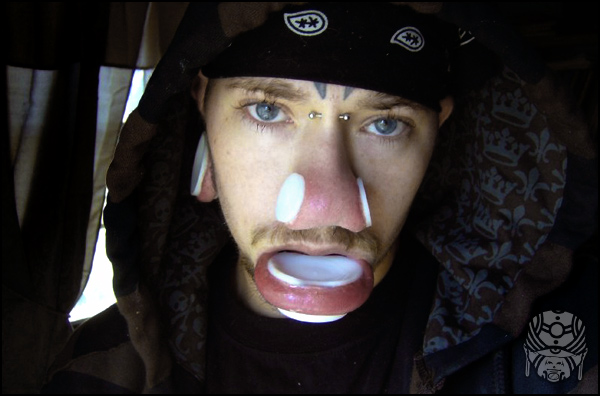 PART ONE How did you do your lip stretching? I got my center lip piercing done at a 16ga — I didn’t have a choice in the matter because the shop I went to only had that size, so when I went home I immediately put it to a 12ga. A few days later I put in an 8ga — my body stretches rather easily I think compared to most people. My steps were either every week or every other week until I got to 3/4″, which was done all with a taper up until that point. Once it got to 3/4″ it became loose every other day, and then I took my steps one millimeter at a time, every other day or so. By this time I was just “popping” them in without tapers or tape — I didn’t use tape until about 28mm. How long did the lip stretching take in all? My lip took a total of six months to go from 16g to 40mm (1 9/16″). How do you usually wear your lip? I wear it down 24/7, even when I eat, but drinking is always with a straw! How about your tongue stretching? My tongue was a different situation. I wanted to split my tongue, but I needed a good back brace, so at first I started my tongue off by scalpelling straight to 6mm, then stretching it up to 9mm the next day. I wore that for four days, and then scalpelled it to 16mm and stretched to 19mm the next day. By then I was ready for the split — I first cut it to 20mm, stretched it to 21mm, and used a scalpel and cut from the underneath up until the plug fell out and my tongue was split. And your nostrils? My nostrils were pierced when I was eighteen at a 10ga and immediately stretched to 8ga. I waited a good four months before going to 6ga, and then every month I went up to the next size until 16mm. Then about every week or so it was 1mm at a time until I took a long break at 22mm — about 5 months. I tapered them the whole way until 5/8″, then slide the next millimeters in by hand. I just recently started stretching them again.  Finally, tell me about your ear stretching? What happened to your ears? My ears have been a work in progress since I was sixteen, when they were done with a gun at the mall. I took it slow the most of the time, but I did stretch a few times faster than I should have. Unfortunately both my lobes were cut by a bad pair of eyelets at 19mm, and then thinned out pretty badly, so I had to take it really slow after that. Then last year I had plastic surgery on my left lobe due to a landscaping accident — I was weedwhacking a lawn at work and a rock got kicked up and split the 1 1/2″ lobe! What are the differences in stretching the different types of piercing? The differences I came across stretching the different types of piercing were that on the ears and lip weight worked really well, whereas the nostrils were all about time — if they didn’t have enough time they just wouldn’t stretch. My tongue was cut the whole time so it was a piece of cake, and I learned that if you really really want a 20mm tongue you can cut it there in a week without a hitch. Did you have any problems in your stretching? I did get some scar tissue on the front of my lip during my journey, which was cut off each time it happened and healed perfectly fine. I didn’t come across any problems with my nostrils, mostly because I was really careful. The have minor scar tissue but it went away with the pressure of o-rings in under a week. With my tongue I didn’t have one problem — besides blood and drool! You managed to upsize all of them incredibly quickly — did you have a secret to doing this or does your body just tolerate stretching really well? I think it’s a mixture of the two — on one hand my body handles stretching really well because I keep it on a basic schedule, and I think my body adjusted to it and went with it for the most part. My goal sizes are 28mm nostrils and a 63mm lip plate. My ears are as is and if they go bigger then good, but if not I’m still satisfied. 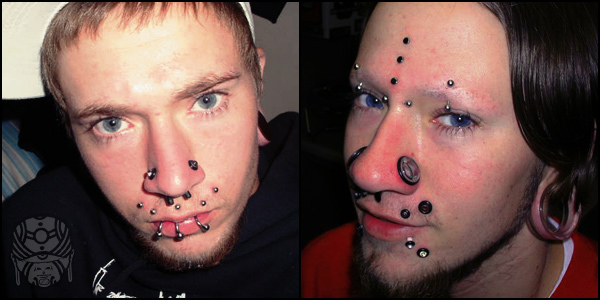 Toph in the early stages of his modifications Are all of your piercings publicly visible, or do you have private mods as well? I have had a 00g PA, a 4ga scalped frenum, three ladders and two pubic surface piercings. I do my own genital mods and plan on starting my full subincision soon — I’ve already done the meatotomy. Do you have plans for further modifications? My future modifications will include more facial ink, full sleeves,scarification, and large conches. It’s a short list but over the years I’ve had a lot of different stuff done and I’m pretty satisfied with the way my image turned out. 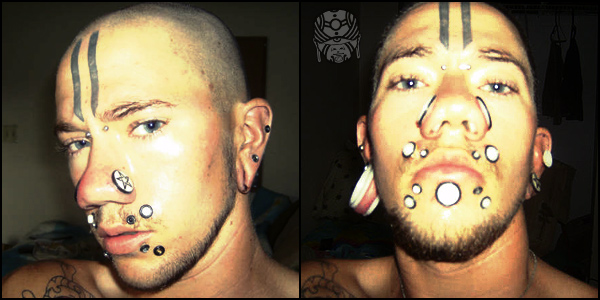 Other facial configurations that Toph has tried And if you change your mind about all of it and want to go back, do you have a “Plan B”? If it ever came to a reversal, I would downsize the same way I went up and hope for the best — but I’ve never once seriously thought about changing my image. I’ve been planning this out and making it a part of my life, and plan on keeping it for life. How much do you think you’ve spent on jewelry so far — you must have gone through a lot? Over the years I’ve spent about $8000 on jewelry. That was another addiction — I collected jewelry, never thinking I would actually wear it all in multiple piercing over the years. I collected anything from normal stainless steel to one of a kind $200 plugs. Once I met Karl (iam:MobyK), he offered to make me Delrin plugs if I ever needed them. At first I was like “no thanks”, but the more I got into it… like you said, I went through a lot of jewelry. Karl became a mentor to me and a godfather — we have been very close friends for about three years now, and have never once met. I met Pauly Unstopable through Karl who showed me how big a nostril can go — he was my inspiration for that single piercing. Jesse (iam:pillpoppinfun, featured in BME’s first article on lip plates) was my original influence for the labret. He wore pins and plugs and it interested me. Throughout the years I’ve had a lot of positive influence through the industry, not to mention the movie ‘MODIFY’ which gave me the idea to scalpel my own frenum. PART TWO How old are you, what do you do for a living, and what “life plans” do you have? I am twenty years old, and currently unemployed. I worked restaurants for five years and landscaping for two before I moved to Oklahoma. Now I’m back at the challenge of finding a new occupation. My life plans are to find someone to apprentice me so I can take what I love and make it into a living. This is my life and it’s what I think about day in and day out. I’m just hoping for the opportunity to get into the modification industry to fulfill my life goal. Tell me a little about yourself in terms of interests? I am a big fan of extreme sports — skateboarding, aggressive inline, four wheeling, motor cycles, and jet skis. I’m big into nature and photography and consider myself a decent artist. 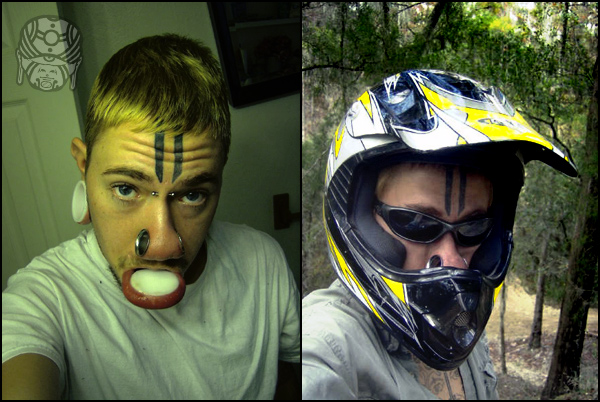 What’s your peer group like? I don’t have a big group friends outside the Internet and I like to keep my life limited to family and close friends for the most part. When I go out in public I like to inform anyone who has questions about myself and what and why I do this, to my best ability, to try to help the public understand that we’re not freaks or assholes. I do this mostly to help the next generation of modders so people don’t get the wrong idea about us — this is very important to me. How do people respond when they see you? When I’m out in public people freak out… when they talk to me, it’s very funny. Once they see I’m willing to talk to them they just let go and ask me a million questions. People jump up and down, spin and laugh, saying “oh my god, that shit is crazy!” I’ve found that I get more attention from middle aged and older African Americans than I do from white teens and young adults… I don’t know why but I like it. What got you interested in body modification originally? I was around fifteen years old and I was a troubled kid, and I met a body piercer named Paul Kriner. He changed my life. I had already had a major interest in body modification, and so when I met him I tried to spend all my free time up at the shop that he worked at. He taught me a lot about the industry, proper aftercare and stretching, and became my mentor and someone I could look up to no matter what. I learned a lot from a young and very talented artist (he was only twenty at the time), and since the day I met him I knew what direction my life was going. I know the why question is hard, but “why?”, and can you think of earlier influences? This is my passion. It makes me very happy doing this, and it satisfies an empty spot in my life. I believe in concentrating and self-inflicting pain — it’s putting myself through more challenges in life… As if life wasn’t hard enough! I don’t think life should be easy, and if you’re doing something you love and it makes your life harder, and you have the ability to work through it, it only makes you stronger. This is the love of my life — more than family and friends even. If I wasn’t able to mod myself I’d feel as if I was walking around as a fake. I also find the way I look attractive — I’m absolutely amazed at what one can do to one’s body to make it completely change form. Really, why should everyone look the same? Like I said, my piercer was a big influence on me in my teens, but as a kid my uncle was in a state prison and all I could see were endless tattoos. He was a great guy — he just screwed up. I had a very positive image of body modification at a young age, although it went against everything my parents ever told me. As a kid I pierced my ears with safety pins and my labret with a sewing needle, as well as numerous surface temporary piercings. The more my parents said no the more I got into it… Then I discovered BME — oh my god, BME — once I was shown that site it was over. It was a candy store for me. I started hanging out at tattoo shops all summer long and every day after school for around five years until I went off on my own. All of this added to my obsession… The interest was already there, but when my eyes were opened to how far it can be taken I never looked back. I dedicated my life to it, and to this day still do and plan on doing it until I die. It’s a part of my life that’s too good to let go. What made you decide to start to push your modifications in a direction that’s far more extreme than most people can relate to? My interest got so deep into it I didn’t see a reason to stop at a certain size just because it was more accepted to stop there — being accepted by the community is something I can do myself no matter how I look. After seeing some of the famous modders like The Lizardman, Pauly Unstoppable, and the movie ‘MODIFY’, I knew I could put up the fight, and so far have succeeded. I take this part of my life so seriously, and I believe you can change the way people think with the right attitude and perspective. It’s all about being nice no matter what, and fully informing them no matter how unbelievable what they see is. Given that you’ve made these changes in such a short time, I’m sure you’ve got some remarkable insight into how people who look different are treated? My immediate family does not accept my body modifications at all, and still don’t completely understand me. I’ve done my best but they don’t want to believe this is who I am. My friends love it — they refer to me as a rock star when we go out in pubic because I have five to twenty confrontations each time I go to a store… nothing but tons of questions, excitement, and disgust. The public is very interested but not everyone can gather the courage to confront someone to ask questions and to fulfill their curiously. You’re always going to get bad attention, but there is a lot more good attention than most people would think. What advice would you have for people who are considering doing something radical like this? I would seriously encourage people to take a long hard thought before doing something like this. You receive so much criticism, and it’s a lot to deal with on a daily basis. It is very difficult to handle and you have to be emotionally strong to get through it all. But if it is a decision the new generation is willing to take, it is only going to get easier as time goes on. Since Valentine’s Day is coming up, would you like to meet and date someone as radically modified as yourself? I believe it would be so much easier to date someone that looked like Duff or Miss Kayteek Etemine because it would be easier to deal with the constant modifications and the public response as well because they would have already been use to it in their own lives, instead of having to adjust to an extreme amount of constant attention. It can be a lot for someone to handle who has never experienced it before. I recently lost my marriage over my body modifications — she told me it was her or the modifications…. I couldn’t believe my ears. I basically laughed, then cried, then said good bye. This path wasn’t meant for everyone and it takes extreme dedication to do what I have accomplished. Not to mention sacrifice… 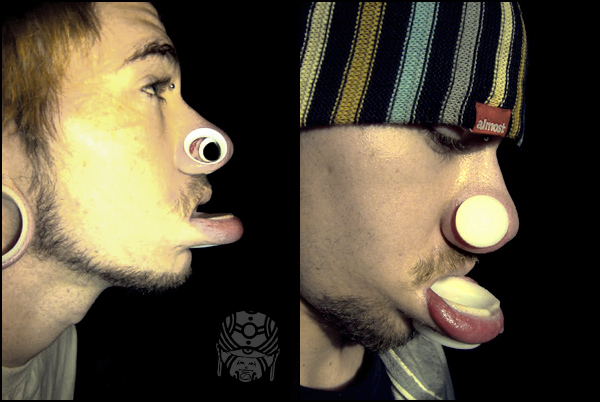 Thank you to Toph for taking the time to talk to us! Please visit him at iam:Toph.
|
